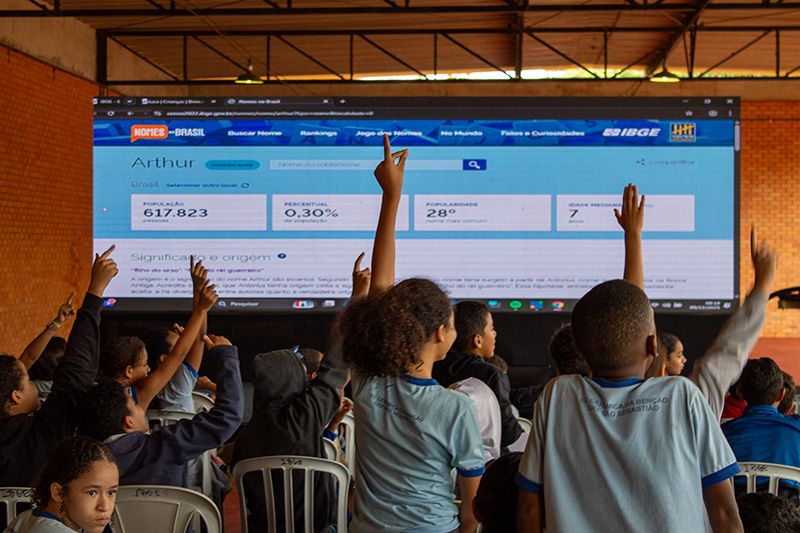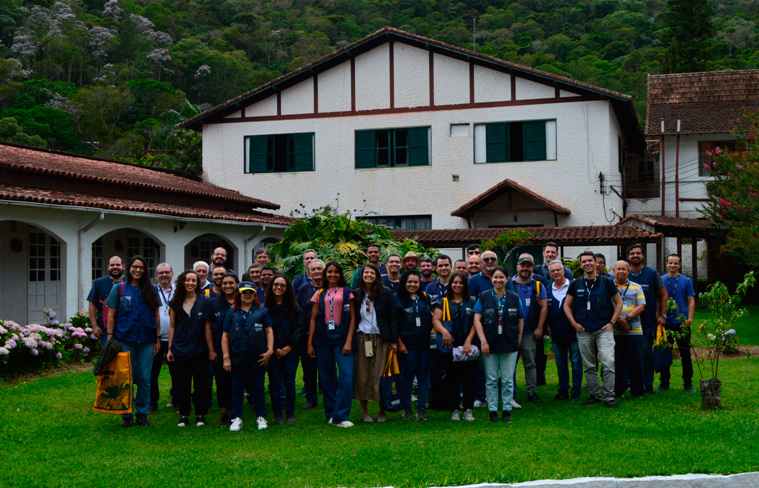PAC
In 2022, populaiton employed in trade reaches 10.3 million and surpasses pre-pandemic level
July 25, 2024 10h00 AM | Last Updated: July 31, 2024 08h52 PM
Highlights
- In 2022, the number of persons employed in trade totaled 10.3 million, an increase of 2.6% compared to the previous year. For the first time, this contingent surpassed the pre-pandemic level, registered in 2019, with an increase of 1.5% compared to this year, or 157.3 thousand more jobs.
- Retail trade accounted for the majority of employment (7.6 million), followed by wholesale trade (1.9 million) and trade of vehicles, parts and motorcycles (846.2 thousand).
- In 2022, 1.4 million trade companies generated R$6.7 trillion in net operating revenue and paid R$318.0 billion in salaries, withdrawals and other compensation.
- The majority of this revenue, 51.0%, was generated by wholesale trade, followed by retail trade (40.2%), and trade of vehicles, parts and motorcycles (8.8%).
- Since the beginning of the time series of the Annual Survey of Trade (PAC), in 2007, the year 2022 recorded the biggest difference between the shares of the wholesale and retail segments, of 10.8 percentage points (pp).
- The concentration among the eight largest companies in the trade sector practically did not change, going from 10.0% in 2013 to 10.1% in 2022.
- In 2022, the Southeast's share of gross sale revenue was 48.0%, a percentage that has fallen since 2013 (52.2%).
- Between 2019 and 2022, the number of trade companies that used the Internet as a form of marketing increased from 1,900 to 3,400, which represents a growth of 79.2%.

In 2022, the Brazilian trade activity included 1.4 million companies, employing 10.3 million persons. This contingent fell 0.7% in a decade, a reduction of 76.6 thousand persons. However, compared to the previous year, there was an increase of 2.6% (263.7 thousand persons). It was the first time that the number of employed persons in the sector exceeded the pre-pandemic level, recorded in 2019. In this comparison, trade increased the number of employed persons by 157.3 thousand, which represents a growth of 1.5%. The data are from the Annual Survey of Trade (PAC) 2022, released today (25) by the IBGE.
“From 2019 onwards, the year 2022 was the first to record a full recovery in employment after the losses during the pandemic, but we have not yet reached the level of 2013/2014, when the highest numbers in the time series were recorded, with 10.4 and 10.6 million persons employed, respectively. From 2014 onwards, we had a period of economic crisis, with increasing unemployment, and this also impacted the trade sector”, recalls the survey analyst, Marcelo Miranda.
In 2022, most trade workers were concentrated in retail (7.6 million, or 73.5% of the total) and the remainder were distributed between wholesale (1.9 million, or 18.4%) and in the vehicle, parts and motorcycle segment (846.2 thousand or 8.2%). This number represents the highest share of wholesale since the beginning of the survey's time series, in 2007.
The three trade activities with the greatest increase in employment in ten years, in absolute numbers, were hypermarkets and supermarkets (growth of 392.1 thousand persons); retail trade of pharmaceutical products, perfumes, cosmetics and medical, optical and orthopedic articles (149.0 thousand); and wholesale trade of agricultural raw materials and live animals (34.6 thousand). The hypermarket and supermarket sector employed 1.5 million persons in 2022 and accounted for 14.8% of those employed in the country's trade sector, the highest proportion among the activities surveyed.
Also in ten years, the greatest drops in employment were in the retail trade of fabrics, clothing, footwear and haberdashery (289.9 thousand less persons), retail trade of construction materials (-110.4 thousand persons) and retail trade of new and used products without specification (-77.4 thousand persons).
In 2022, the average size was seven persons per trade company
Another point to be observed in the employment of the trade sector is the average size, that is, the average number of workers per company. In 2022, in general commerce, the average was seven persons per company, which represents a small increase compared to 2013, when it had been six persons. In the large trade sectors, this number was similar: six in companies in the motorcycle, parts and vehicle segment, eight in wholesalers and seven in retailers.
When this indicator is evaluated by groupings of trade activities, there is a large change in the average size. The highest average was in the hypermarket and supermarket sector (119 persons per company), followed by wholesale of general goods (25 persons) and wholesale of fuels and lubricants (23 persons). On the other hand, the smallest sizes were in companies in the activities of representatives and agents of trade (one person) and retail trade of new and used products without specification (four persons).
The publication also assesses the structure of the labor market in the retail sector based on the average wage paid to workers. In 2022, companies in the sector paid an average of 2.0 minimum wages (m.w.). In wholesale, the average was higher (2.9 m.w.) than in the motorcycle, parts and vehicle sector (2.3 m.w.) and in retail (1.7 m.w.). These three segments recorded an increase in this indicator in the last two years of the survey (2021 and 2022).
Compared to 2013, average wages also increased in the three trade segments. In the vehicle, parts and motorcycle and wholesale activities, the increase was 0.1 m.w., while in retail, it was 0.2 m.w.
Wholesale activities paid the highest averages: wholesale trade of machinery, appliances and equipment, including IT and communications (4.4 m.w.); wholesale trade of fuels and lubricants (4.4 minimum wages), and wholesale trade of pharmaceutical products, perfumes, cosmetics, and medical, optical, and orthopedic articles, office supplies, stationery, and household goods (4.1 minimum wages), whose average wages increased the most in the period (0.5 minimum wages).
“The wholesale trade of fuels and lubricants, which paid one of the highest averages in 2013, lost 1.8 minimum wages in these ten years. Although it continues to be one of the sectors with the highest average wages, there was a more drastic reduction in this activity,” says the analyst.
On the other hand, the lowest wages were in the activities of trade representatives and agents (1.3 minimum wages) and retail trade of food products, beverages, and tobacco (1.3 minimum wages).
Wholesale accounted for 51% of sales in 2022, the highest rate in the series
In 2022, trade companies recorded a total gross revenue of R$7.2 trillion. Of this amount, R$621.1 billion came from the trade in vehicles, parts, and motorcycles; R$3.7 trillion from wholesale trade; and R$2.9 trillion from retail trade. The net operating revenue, that is, revenue free of deductions such as canceled sales, discounts, ICMS tax on sales, and other taxes, was R$6.7 trillion.
Wholesale trade grew 6.7 percentage points between 2013 and 2022 and remained the most representative area in the sector, with 51.0% of total revenue, the highest rate since 2007. Retail trade, the segment that led between 2014 and 2019, recorded a loss of 2.7 percentage points, but kept the second place, with a share of 40.2%, the lowest rate in the last ten years. The trade of vehicles, parts and motorcycles was the one that had the greatest reduction in representation, with a loss of 4.0 pp. From the beginning of the time series, in 2007, up to now, the year 2022 recorded the greatest difference between the shares of the wholesale and retail segments (10.8 pp).
Over the last ten years, the largest representation in net operating revenue was from wholesale trade of fuels and lubricants (12.7%), which grew by 2.5 pp. Hypermarkets and supermarkets (11.4%), which ranked first in the participation ranking until 2021, fell to second place in 2022. Wholesale trade of food, beverages and tobacco (8.6%), which was the fourth most relevant activity in 2013, took the third place in 2022.
Wholesale trade in agricultural raw materials and live animals was the group that grew the most between 2013 and 2022 (3.7 pp), moving from the16th to the fifth place. On the other hand, trade in motor vehicles was the activity that lost the most share in the 10-year analysis (-3.6 pp), and went from third to seventh place.
When comparing 2022 with the pre-pandemic period (2019), it was worth noting that hypermarkets and supermarkets were the group with the greatest loss in revenue share (-1.5 pp).
Sales margin reaches R$1.4 trillion in 2022, but margin rate falls in ten years
Sales margin - the difference between net sale revenue and the cost of goods sold - was R$1.4 trillion in 2022. The retail trade was responsible for the largest share (50.3%), the lowest value between 2013 and 2022; followed by the wholesale trade (41.8%), the highest value in the time series since 2007; and trade in vehicles, parts and motorcycles (7.9%).
The margin rate, defined as the marketing margin divided by the cost of goods sold, fell from 30.5% in 2013 to 27.9% in 2022, a drop of 2.6 percentage points. This was mainly due to the reduction in the margin in retail trade, which fell from 39.9% to 36.5%, and in wholesale trade, which fell by 3.0 percentage points, resulting in 22.1% in 2022.
The trade in vehicles, parts and motorcycles saw growth in this indicator (4.4 percentage points) in the same period, reaching 24.7% in 2022, the highest margin in the entire time series since 2007.
Market concentration of the eight largest companies remains stable in ten years
The "concentration ratio of order 8" (R8), which indicates the percentage share of the eight largest companies in the net revenue from sale in the sector, practically did not change. The eight largest companies in the retail sector went from 10.0% of the market share in 2013 to 10.1% in 2022.
In the retail sector, the R8 was 10.1% in 2022, an increase of 1.9 percentage points over the period. Although the sector in general has low concentration, one of the activities that comprise it - the retail trade of IT, communications and household goods - is among the three largest in the sector, with an indicator of 41.7%.
With a reduction of 3.3 percentage points in 10 years, wholesale trade obtained, in 2022, an R8 of 17.4%. Two of the three activities with the highest value of the indicator, among the 22 analyzed, are in the wholesale segment: the wholesale trade of fuels and lubricants, with the highest R8, of 61.0% in 2022; and the wholesale trade of goods in general, with an R8 of 32.9%.
"However, it is worth noting that the wholesale trade of fuels and lubricants was the one that had the biggest decrease in relation to 2013, with a drop of 13.8 pp", highlights Mr. Miranda.
Southeast trade continues to have the highest revenue in 2022
In 2022, the trade operating in the Southeast continued to have the highest numbers of gross sale revenue, local branches, employed persons and compensation. Next came the South, Northeast, Central-West and North regions. This order in the ranking has been the same since the beginning of the time series in 2007.
The Southeast accounted for almost half (48.0%) of gross sale revenue in 2022, a share that fell since 2013, when it represented 52.2%. This drop mainly benefited the South, which went from 19.6% to 21.5%, and the Central-West, which grew from 9.5% to 11.9% in this period.
The number of employed persons in the trade sector in the Southeast was estimated at 5.2 million, a drop of 2.9% since 2013, which represents 157.0 thousand less. During this period, the South lost 31.5 thousand employed persons (a drop of 1.5%), and in 2022, its population employed in the trade sector was 2.0 million persons. In the other regions, this contingent increased: in the Northeast, the number of employed persons reached 1.8 million, an increase of 24.4 thousand workers in ten years; in the Central-West, there was the largest increase (49.2 thousand persons or 5.7%) and this contingent reached 908.5 thousand persons, the largest in the time series; and in the North, with a gain of 38.4 thousand persons (or 11.8%), the number of employed persons reached 364.9 thousand.
There are also differences in relation to the average salaries paid in the trade sector in the regions. The Southeast was the only region where this indicator was above the national average (2.1 m.w.). In the South, the average salary was exactly the same as the national average (2.0 m.w.). The others were below: Central-West (1.9 m.w.), North (1.8 m.w.) and Northeast (1.5 m.w.).
In ten years, only trade companies operating in the South and Central-West increased their average salary by 0.2 m.w. In the North, Northeast and Southeast, there was an increase of 0.1 m.w.
Among the Federation Units (UFs), São Paulo continues to account for the largest share (28.6%) of the country's commercial revenues. However, in the last ten years, São Paulo's tarde has lost share (-3.5 pp), the largest drop among the FUs. Minas Gerais maintained its position as the second most representative (10.0% of the total), while Rio de Janeiro, which was the third state with the largest share in this ranking, fell to sixth place in 2022, a drop of 2.2 pp.
Internet sales grow 79.2% between 2019 and 2022
In the previous edition (2021), the survey began to disclose data on Internet sales for companies in the right sample stratum, that is, those with 20 or more employees or with a high level of revenue. The Internet appears in the PAC questionnaire as one of the forms of sales available to companies, including sales via websites, apps, social media and instant messaging apps. Between 2019 and 2022, the number of commercial companies that used this method increased from 1.9 thousand to 3.4 thousand, an increase of 79.2%.
“In 2019, only 4.7% of companies carried out some type of marketing via the Internet and, in 2022, this value rose to 8.0%. There was a jump from 2019 to 2020, which was already expected due to the pandemic, and then, a smaller growth in the following years”, points out the researcher.
Regarding the retail activities with the greatest share in the number of companies that sell via the Internet, the following stand out: IT, communication and household goods (20.3% of the total), construction materials (16.3%) and fabrics, clothing, footwear and haberdashery (15.0%).
“We observed that the IT, communications and household goods sector was the most relevant in relation to the total number of retail companies that sell online. However, it was also the one that had the greatest loss of share since the pre-pandemic period, a drop of 4.2 percentage points”, explains Mr. Miranda.
Also in relation to the pre-pandemic period, the percentage of gross retail revenue related to purchases made online increased from 5.3% in 2019 to 8.4% in 2022. However, compared to 2021, there was a reduction of 0.7 percentage points.
“In 2022, especially from the second half of the year, when trade and services were fully reopened and restrictions were eliminated, sales that are not online may have been boosted, causing the relevance of online commerce to fall”, he analyzes.
The activities with the greatest gains in gross revenue from sale via the Internet between 2019 and 2022 were hypermarkets and supermarkets and retail trade of pharmaceutical products, perfumes, cosmetics, and medical, optical, and orthopedic articles (both with 3.1 pp). The one that recorded the greatest drop was the retail trade of IT, communications, and household goods (-3.8 p.p.). Despite this, this activity still accounts for the majority of these revenues (60.4%).
More about the survey
The Annual Survey of Trade (PAC) 2022 seeks to identify the basic structural characteristics of the business segment of trade activity in the country and its transformations over time, covering, among other aspects, data on employed personnel, salaries, revenues, costs and expenses, marketing margin, and value added. The survey provides data for Brazil, Major Regions, and Federation Units.




















